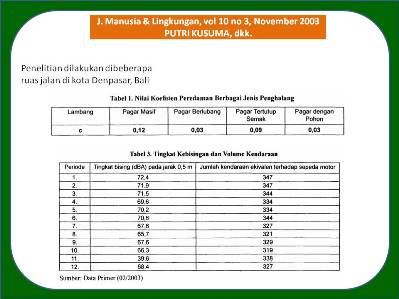
ANALISIS SIFAT AKUSTIK PAGAR PEMBATAS SEBAGAI PEREDAM BISING KENDARAAN BERMOTOR: SALAH SATU ALTERNATIF PENGENDALI BISING DI KOTA DENPASAR (Analysis on The Acoustic Characteristic of Fence to Reduce Noise from Motorized Vehicles: One of The Alternatives)
Putri Kusuma(1*), Sudibyakto Sudibyakto(2), Dewi Galuh(3)
(1) Universitas Udayana
(2) Fakultas Geografi Universitas Gadjah Mada, Yogyakarta
(3) Fakultas Geografi Universitas Gadjah Mada, Yogyakarta
(*) Corresponding Author
Abstract
ABSTRAK
Salah satu sumber kebisingan di daerah urban adalah kendaraan bermotor. Upaya untuk menghadapi kebisingan ini adalah mengendalikannya dengan cara memasang penghalang (barrier) dalam bentuk pagar, seperti misalnya pada arsitektur tradisional Bali. Penelitian ini bertujuan untuk melakukan studi tentang efektivitas berbagai macam pagar dan tentang efek pagar ini dan jumlah kendaraan bermotor terhadap tingkat kebisingan yang ditimbulkan. Penelitian ini dilaksanakan berdasar pada standar (ISO) R 1996, atau Equivalence of Noise Level of n number of sample. Penelitian ini mengadopsi sampling purposif untuk memilih jenis penghalang, dan berfokus pada objek berikut: (1) jenis pagar, (2) jarak dari sumber kebisingan, dan (3) jumlah jenis kendaraan. Efektivitas penghalang diekspresikan dalam jumlah reduksi kebisingan dari suatu kebisingan, baik menggunakan atau tidak menggunakan penghalang, serta koefisien keheningan (coefficient of muting) dari setiap penghalang. Tes untuk menganalisis data meliputi korelasi untuk mengetahui efektifitas penghalang, dan tes regresi untuk mengetahui hubungan antara jenis kendaraan dan tingkat kebisingan. Penelitian ini menemukan bahwa pagar masif merupakan pengurang kebisingan yang paling efektif diantara jenis-jenis pagar yang ada, dengan koefisien 0,12, tetapi jenis ini memiliki kekurangan elemen estetika dan memberikan kesan individualistik ditambah lagi bahwa struktur tersebut menghalangi pandangan apa yang terjadi diluar. Pagar yang berselang-seling dan ditutupi dengan vegetasi lebih baik ditinjau dari sisi estetika maupun fungsi fisik untuk mengurangi kebisingan, dengan koefisien 0,09. Relasi antara tingkat kebisingan dan jumlah kendaraan dapat diidentifikasi dengan menggunakan persamaan linier dengan memberikan jumlah kendaraan yang equivalen dengan jumlah sepeda motor.
ABSTRACT
One of the sources of noise in urban areas is motorized vehicles. An attempt to deal with noise is to control it in its tract by setting up barriers in a form of fence, especially that in Balinese traditional architecture. The research aims to study the effectiveness of different kinds of fence and to study the effects of these fences and the number of vehicles on the noise level produced. The research was conducted based on the (ISO) R 1996 standard, namely the equivalence of noise level of n number of sample. It adopted a purposive sampling select the type of barrier, and focused on the following research objects: (1) type of fence, (2) distance of measurement from a noise source, and (3) type number of vehicles. The effectiveness of a barrier is expressed in the amount of noise reduction from a noise, either with or without barrier, and the coefficient of muting from each barrier. The tests to analyze the data are the correlation test to know the effectiveness of barrier and the regression test to know the kind of relationship between the type of vehicle and the noise level. The research found that a massive fence is the most effective noise reducer among different tyes of fence, with coefficient of 0.12. However, it offers less aesthetic element as it gives a impression of individualsm in addition to its structure that obstructs the eyes to see what is happening ourtside. A fence with gaps covered with vegetation is better both from the esthetic point of view and from physical function that is to reduce noise, with a coefficient of 0.09. The relation between the noise level and the number of vehicle can be identified by using a linear equation approach by putting the equivalence of the number of vehicle with that of motorcycle.
Full Text:
ARTIKEL LENGKAP (PDF) (Bahasa Indonesia)Article Metrics
Refbacks
- There are currently no refbacks.
Copyright (c) 2017 Jurnal Manusia dan Lingkungan







